The Areola Architect: Cathi Locati
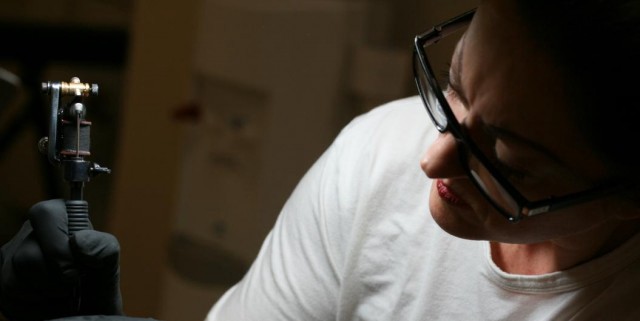
EDITH: Cathi, you’re an artist who — among other things — tattoos renderings of nipples and areolas onto women who’ve lost parts of their breasts to cancer and surgery. The photos in your gallery, and in your photo book, might classify in some places as not safe for work, but we’re including them throughout this interview.
You mentioned to me in an earlier email that you’ve been inspired, style-wise, by Michelangelo. How does that translate onto the human body?
CATHI: It isn’t so much that I’m inspired by Michaelangelo, but I use this analogy when I’m explaining what I do to new audiences of men and women who have no idea what I’m talking about when I say I tattoo areolas and nipples in 3D-style, or photorealitically. When I say I tattoo areolas and nipples “in the style of Michaelangelo,” heads then start nodding yes, they get it. Kind of … they still need to see “before and after” breast photos, or look at the sample of the areola and nipple I have printed in black and white on the back of my business card. However, using my 30 years experience as a portrait and figure painter, I literally translate this photorealistic ability from canvas to skin, “painting” — with a tattoo machine — areolas and nipples that appear round, 3D, protruding, and life-like enough that it’s sometimes hard to tell which is real.
Do you remember the first areola[s?] you tattooed?
I will always and forever remember my very first one. She will always be special to me. I was pretty much terrified but confident that I could do it, even as I was being watched by the surgeon who performed the reconstruction. I pretended my patient was my blank canvas and rendered the same thing on her skin as I would on a painting; all the same rules of light and shadow, composition and color, etc., apply, regardless of medium. At least, that was my hope! And my very first set of areolas and nipples look as grand as any I do today. I found in the beginning that I had to turn off the empathy I feel for “my ladies” and turn on “artist mode.” If I didn’t do that, I’d be too worried about whether or not I was hurting them (most of it is mental for me). However, using my minimalist technique of less ink and needling rather than more (or, when painting, less rather than more paint) and allowing the skin (or canvas) to be an active color, I don’t have to add color as a base — it’s already there. This is why my artwork looks vibrant and real — and why the areoalas/nipples I tattoo are done quickly and efficiently, and are accurate and PERMANENT. (Surgeons’ tattoos, as opposed to tattoo artists’ tattoos, sometimes fade and disappear.) To see an example of my minimalist technique, go to cathilocati.com — Early Works, then click on Burnt Purple Rhythm. All the white space in that painting is untreated canvas — there are no brushstrokes there. The dark colors that make up the painting is the artwork itself and identical to my technique on skin. Less is more with tattooing on the sensitive breast, and it’s easier for the patient to endure.
Photos of Cathi’s work after the jump.
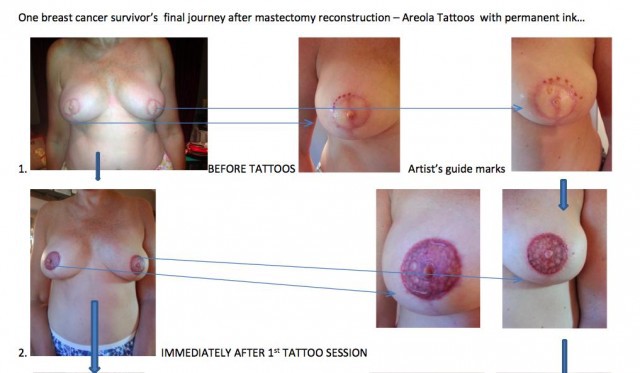
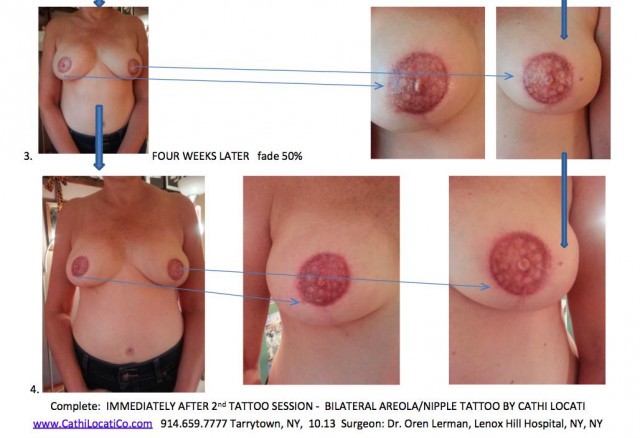
Do YOU have any tattoos?
Yes, I have one tattoo on the inside of my left arm. With both my son and daughter looking on, for my 50th birthday I tattooed their names on my body for everyone to see instead of hiding it under clothes. I made a conscious decision to do this for my ladies who choose to undergo the same thing. I needed to know what I was dishing out! The tattoo I have is a symbiotogram — one word that shares a symbiotic relationship with itself — as it reads two ways to show two words within one: Sarah (my daughter) and Tyler (my son) when flipped over.
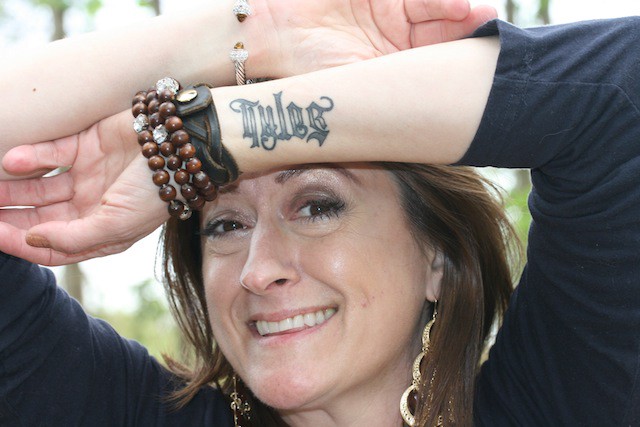
It was tattooed by my colleague and friend Chuk Hognell, owner of Mighty Horseman Tattoo Co., in my hometown of Tarrytown, New York (Westchester County). An important note: without Chuk’s acceptance of me as an artist with potential and his personal guidance with tattooing, I would not be offering this service today. Not only will I be forever grateful for this man’s talent and assistance, but thousands of breast cancer survivors are forever grateful to him, too. Trivia: Tattooing in Tarrytown, up until 2012 (last year), was a FELONY — but Chuk changed all that, working with the village administration to change the local code and rewrite the law so that he could open his tattoo studio, which in turn allowed me to perform areola procedures. Here’s a picture of the two of us…
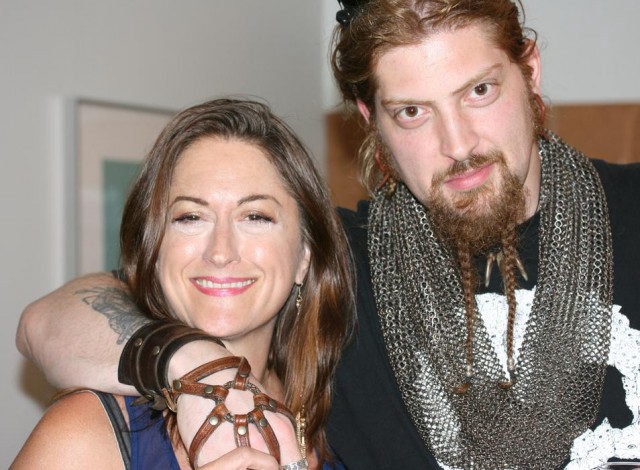
Do you keep in touch with many of the women you’ve worked with?
Absolutely! I love my ladies! I send them regular newsletters about recent and upcoming events I’m doing, like my Indiegogo campaign [to raise money to give cancer survivors free tattoos], and TV and radio shows I’ve been on. Each of my patients has given permission for me to use their photos to help other breast cancer survivors. I also enjoy hearing the husbands and boyfriends comment, as well as the daughters and sons who see their mothers’ new chests … as young as four years old — they see the artwork and are often amazed. I call them regularly to see how they’re doing, and I ask them to keep in touch with me for the rest of their lives. My ladies are out there every day telling others, showing others about the procedure and joy they feel.
I noticed that some of the tattoos incorporate shadows — how difficult an element is that to work with?
So many elements of the areola/nipple tattoo involves shadow and light — that’s what realism is all about. And it’s also why, with all due respect and no offense implied, surgeons/nurses generally shouldn’t be doing tattooing — unless they can draw on paper or skin with a simple pen a real-looking areola/nipple, in 60 seconds. That’s the test. If they can’t do this, in my opinion, they shouldn’t be picking up a tattoo machine. As the law stands now, surgeons and nurses are allowed to do tattooing with no previous experience, zero tattoo training, and varying quality standards. The discs of color they put on skin can look like pepperoni: flat, lifeless, and likely to fade and disappear. (There’s sometimes also a lot of unnecessary and incorrect needling, which causes extra wear and tear on the patient.) But when artists attempt to to make something look 3D, they ask themselves: where is the light coming from and where would the shadow fall? I mark arrows on my patients’ chests dropping down from the supra-sternal fossa (base of neck in front below the esophagus, tracheotomy area) in both directions to remind myself as I am tattooing, where the light is coming from and where the shadows would fall. I teach this basic step with every art student, every time…regardless of medium.
Have people ever been dissatisfied with the results?
One woman was dissatisfied after the second session because the color combination, which I’d used on previous patients, healed on her a little more on the lavender side than she wanted. After a third session using another color combination, she’s now thrilled. I remind everyone that like paint you roll onto a wall, if you don’t like it — it’s paint after all, change it to another color. Keep working with it. No two people are alike in this field — as each cancer is different, each surgery is different, and what type of skin is left when all is said and done is always going to be different than someone else’s — there are no two alike. Each person’s body chemistry when thrown into that mix is different, too. That’s why I offer two sessions within one price — the first session I place the areola and nipple with the color combination we both feel will get us closest to the patient’s final vision. Within 3–6 weeks it is mandatory that the patient returns after full healing for a second session so that we can see what colors the body pushed out, and which colors it kept, and we forge on to finish in the second session with exactly what that body wants and needs.
Here is a testimonial that made me cry and keeps me doing what I do!
Good Morning, Cathi.
Just a quick update. All is well, no reaction at all to yesterday’s session. I showed my husband this morning and he said “WOW, they look great”. He couldn’t tell the difference between the natural and reconstructed nipple! The emotions I feel right now have taken me by surprise. Being my breast cancer was 5 years ago, I had accepted that my nipple was as good as it was going to get which I have reluctantly accepted. I am so very grateful to you and cannot express the words I feel right now. You have made me whole again; something I thought could never happen during my lifetime. I have tears rolling down my face as I type this as I let go of everything that has happened. You have rolled back time for me and brought me to a place when I didn’t even know that cancer existed. I look forward to the final session to further perfect my new nipples which are already amazing!! I will be sure to follow your instructions to the letter to get the best outcome.
Rest assured I will spread the word to other women who have been through it and those that will come to me as they face it. Thank you, thank you, thank you for taking on this very needed step in the healing process.
Fondly,
Margaret
I’m embarrassed to admit that I didn’t know what Montgomery glands were until I read about them on your site. Can you briefly explain for anyone else who might not know? (I hope I’m not just clueless!)
This is exactly what I’m talking about with the need for education, and about my responsibility as a professional in this field, to help women learn the words for their body parts before things are removed and altered. I didn’t know what Montgomery glands were called, either, before I got into this business, so don’t feel bad! However, how sad it is that in this era of free information we don’t talk about our bodies enough to call our parts by their right names!
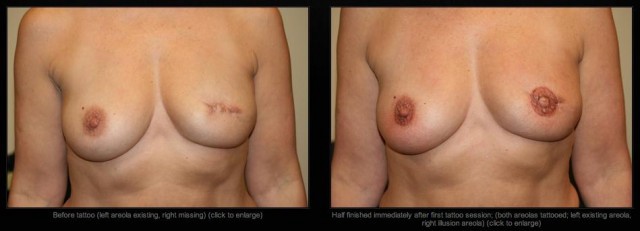
You are not clueless — you are the reason why I am making speeches, doing presentations and lectures, and why I’m very grateful for this Hairpin opportunity! The Montgomery glands are the little bumps inside the areola (and because some people don’t know what the areola is either, it’s the colored skin that rings the nipple — it’s not the nipple itself), I tattoo Montgomery glands as a matter of course to simulate the tricks of light and shadow. The inclusion of the glands in my tattoo work is what the eye sees and accepts as protruding and round. I want to mention that I use topical anesthetics to help reduce discomfort during the procedure, and the majority of women are amazed and thrilled after the first few minutes of the first tattoo needling to discover it hardly hurts it all, and that they can more than handle the process! Most are scared to have the procedure done, and I recognize their bravery, but together we start laughing and doing the happy dance when it turns out to be so much easier than they’d thought!
Who else does areola tattooing, and what should someone consider when trying to find a post-surgery tattoo artist, if they’re interested? (If they can’t get an appointment with you!) And what are the pros and cons of getting areola tattoos in general?
There are very few of us who perform this procedure, and I am the only one I know who tattoos as though the breasts are paintings, instead of tattooing a standard round disc or the same for everyone. Each areola/nipple I tattoo is unique and custom designed for that person’s weight, skin type, and color, as well as their hair color and personal preferences. I tattoo a distinct left areola and a distinct right areola. No one design fits all. I am aware of one other individual in Maryland who does the work out of his tattoo shop (Vinnie Myers).
When patients are considering a tattoo artist, they should ask if the tattoos are permanent or temporary, and if the person doing the procedure can produce regular flat discs of color or round, projected 3D-style illusion. If considering a surgeon or nurse for the tattooing, ask to see photos of their previous work, and I would strongly encourage people to not undergo additional surgery of any kind in the attempt to achieve permanent color using skin grafts. There is, in my opinion, no solution to attaching permanent color to the body besides tattooing with permanent ink. Nipple-protrusion surgery usually doesn’t work, either: they tend to flatten out and are hard for the surgeons to place accurately — I fix these nipples, sometimes tattooing right over them, so why make them in the first place? A second typically unnecessary surgery is cutting into the skin to give the illusion of a round areola. Same thing: they are often not placed correctly — too high or too low, or one is high and the other is low — and they tend to heal square or oblong, and often look like scars cut into the skin. But mostly my advice would be: If they don’t have pictures of tattoos they’ve done, don’t do it.
Although I’m not speaking from experience, it seems important to acknowledge that it’s a very personal choice, and I imagine it’s possible to feel sexy with any combination of nipple/areola/breast or lack thereof.
Not necessarily … I see this as bravery and accepting what is, because what’s done is done. Most women don’t want to be negative, although in their heart of hearts, not very many women want their breasts removed and then like the way it looks. I have heard women say this UNTIL they see the high quality areolas I am able to produce. Many women who’ve chosen to get flowers and dragonflies elsewhere — full vests tattooed over the entire chest as though actual clothes, because they do not know the full range of options available to them — haven’t seen my work yet! Because when they do, THAT’S when they get really excited.
How do celebrity happenings like Angelina Jolie’s mastectomy and Times essay affect your work? Is there anything you’d say to her (or other mastectomy / breast cancer survivors) if she were reading?
Yes — I can’t seem to figure out whether Angelina was lucky enough to have had her areolas/nipples spared. I would like her to know, as well as Christina Applegate, Suzanne Somers, Sharon Osbourne, Kathy Bates, Miss America — any celebrity who wants the very best and most gorgeous areolas/nipples available today that are permanent and in full living color, to have me do the procedure.
I have had a breast reduction myself, with many scars like my patients; I am a cervical cancer survivor; I am a master of anatomy and faces; and I’m a woman! Again, if anyone’s considering a nipple/areola tattoo artist, please ask the artist how much fine art training they’ve had BEFORE they learned to tattoo, whether their ink temporary or permanent, and whether they specialize in areolas (I do!).
What are your goals going forward?
I want to spread the word and educate patients and surgeons alike on an artistic approach with proper technique for performing Areola and Nipple micropigmentation procedures. I want to establish quality standards so that great results are a given and not an accident. Currently, according to the Women’s Health and Cancer Rights Act of 1998: “patients whose health plan covers mastectomies are entitled to full insurance coverage for post mastectomy reconstruction, including nipple micropigmentation.” This is wonderful news for breast cancer survivors to know. As an out-of-network provider, I work hard with my patients to get them reimbursed by their insurance company — and we do get reimbursments! The insurance companies attempt to inform the claimant that ONLY surgeons or nurses can perform the areola procedure, but this is not true! Breast cancer survivors can choose anyone they want and will get reimbursed according to federal law. The reality: ONLY specifically trained, highly specialized areola tattoo artists should be doing the procedure, and not doctors or nurses (unless they are trained in tattooing and anatomical fine art). I hope to change legislation about this entire industry in general — change the law as currently written to stop harming breast cancer survivors.
So many wonderful people are coming forward to help breast cancer survivors, including Glenn Butler, CEO of Life Support Technologies (lifesupport-usa.com). Glenn’s company provides hyperbaric chambers to hospitals for fast wound healing (including the use of hyperbarics during the breast cancer process). Life Support Technologies has been the single most influential sponsor in funding the Souvenir Bundles that my fine art company produces to fundraise for the hospitals. (I produce, on commission, sketches of local scenery that are then packaged inside $25 bundles of fine art. These images are high quality, lightweight for suitcases when traveling, affordable, and raise funds for hospitals!) Glenn Butler saw the value in the concept long before the final production happened (with Ashikari Breast Center as sponsors). Glenn’s timely support in turn financed and redirected my areola/nipple business efforts. An eternal and forever thank you to Glenn for helping all of us come together. See the Souvenir Bundles at: www.cathilocatico.com, click on Souvenir Bundles/Pastiche. These are available for purchase — contact me through my site!
How else can people contribute or help?
They could post the front and back side of my business card on Facebook (the backside has the federal law about reimbursement):
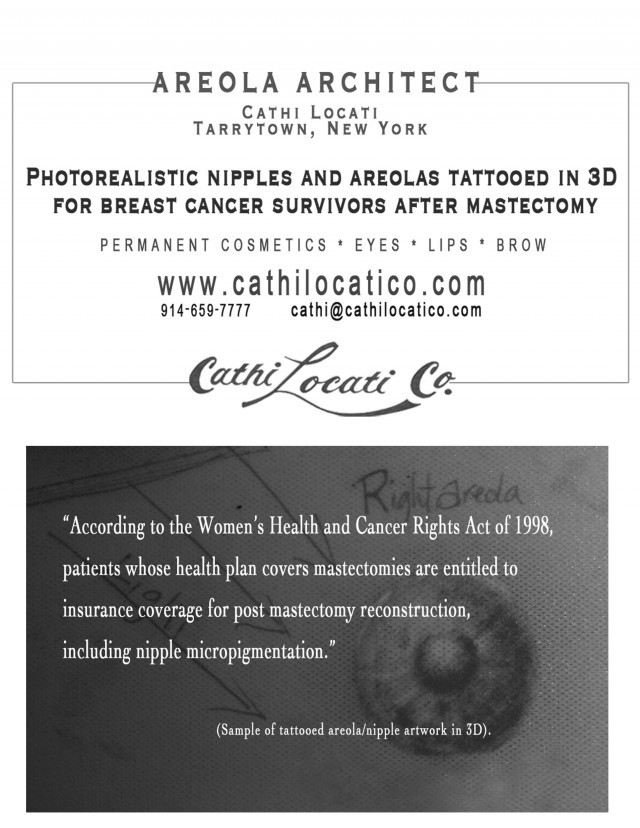
Or they could post the Shutterfly link to the photo book on Facebook…
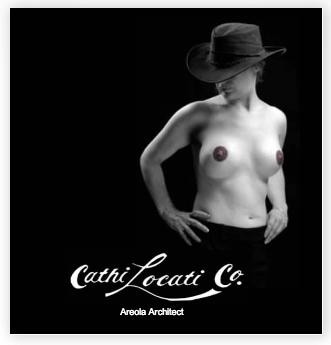
…or just start telling everyone who needs to know! Start talking to surgeons so they stay informed, start talking to TV talk show hosts and ask them to have me appear as a guest on their show (!) — the more women we reach all at once, the greater audience, the greater the education, and the more fantastic final results. I have a long list that unfortunately is growing of survivors who need the areola tattooing service and have no insurance. Call me and donate the cost! I can perform as many areolas as people wish to pay for. I do many pro bono as it is — just to help out. Ask the American Cancer Society, Susan B. Komen groups to add my business to their list of recipients so that a portion of the tremendous funds being raised for breast cancer will go to women who have survived but are left with scars and no nipples/areolas. Invite me to speak to your convention, luncheon, seminar — start talking! I’m here and available to help — just ask. Help me get in front of as many survivors as I can! I am in need of a Public Relations firm who can represent my work without fee or at a reduced rate until word gets out that I’m here! I am seeking an angel investor for seed capital who can assist me in taking my business to the next level.
If you know a breast cancer survivor, start the conversation — ask this question to survivors: “What have you been left with as far as aesthetics? Are you happy with how you look now? Do you have a lot of scars and no areolas/nipples? Do you know there are tattoo artists who specialize in creating new areolas and nipples?” If you are a surgeon or you know plastic surgeons doing their own tattooing, ask them to look at my work and if they still feel they can do as well or better, then they should continue. If not, give me a call. I travel anywhere in the world with a 3–5 patient minimum (within the U.S.), 5–7 patient minimum (outside the U.S.), or if a single patient pays travel costs.
…. If you’re a breast cancer survivor — even if it was years ago — you can still have your areolas/nipples back in full living color! Start talking about this topic. But most importantly, whether you end up using my services or not, I will talk to you free of charge! DON’T WAIT TO TALK TO ME UNTIL THE END OF YOUR RECONSTRUCTION — CALL AS EARLY AS POSSIBLE AFTER DIAGNOSIS. You need to know micropigmentation options early, so that you have the least amount of surgeries with the very best results. I will teach you body part names, give you options, show you pictures and educate you so that as you go along, you will make the best decisions based on what you know is available and won’t be given info from just one source with one idea — you will be in charge of you!
In acknowledgment of the most humble, talented and forward-thinking plastic surgeons I have had the pleasure to work with, I mention these great doctors in Westchester County who have put down the tattoo machine, keeping their patients best interest at heart, and refer patients to me — and without whom I would not be as successful as I am today:
New York Group for Plastic Surgery (New York, Goshen, Tarrytown, Cortland Manor, NY)
-Dr. Andrew Salzberg
— Dr. Michael Koch
Hudson Valley Hospital, Ashikari Breast Center (Cortland Manor, NY)
— Dr. Roy Ashikari
— Dr. Andrew Ashikari
— Dr. Pond Keleman
Lenox Hill Hospital (NYC):
— Dr. Oren Lerman
Thank you, Cathi!
Thank you for the opportunity, Edith.
More of Cathi Locati’s work can be found on her website and in her photo book.